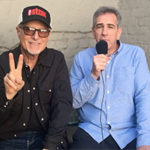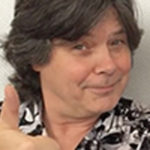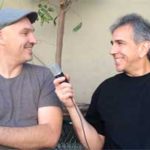Seasoned bass veteran and passionate educator recounts career highlights while offering solid advice for musicians
Exclusive interview with FBPO’s Jon Liebman
May 20, 2013
Bob Magnusson is a world-renowned jazz, pop and classical bassist and much sought-after string bass teacher. His extensive studio work includes everything from jazz recordings, TV commercials, film scores and jingles to over 150 albums and CDs.
In addition to stints with the Las Vegas Symphony Orchestra and the San Diego Symphony, Magnusson has performed with many pop and jazz greats, including Buddy Rich, Sarah Vaughan, Jimmy Cobb, Art Pepper, Benny Golson, Joe Farrell, Linda Ronstadt, Natalie Cole, Neil Diamond, Bonnie Raitt, Madonna, Hank Jones, Cedar Walton, Jimmy Heath, Freddie Hubbard, Slide Hampton, Billy Higgins, Tommy Flanagan, Kenny Burrell, Peter Erskine, Joe Pass and countless others.
A passionate educator, Bob served as an active faculty member at the Musicians Institute in Hollywood from 1977-96. He has also taught at San Diego Mesa Community College, the Coronado School of the Arts, Centrum School of Creative Arts, San Diego State University and Point Loma Nazarene University, as well as privately. Magnusson is the author of The Art of Walking Bass, published by Hal Leonard Corporation.
FBPO: How would you describe your musical upbringing?
BM: I was born in New York City and raised in a musical family while my father was attending the Juilliard School of Music on a clarinet scholarship. My mother was a classical pianist. I began studying piano with my mother at 5 or 6 years of age. After that, I studied French horn continuously for twelve years. My hope was to play in a major symphony orchestra.
FBPO: How did you become a bass player?
BM: In my teenage years, through groups like The Kingston Trio, I became interested in the guitar. While continuing the French horn, I also took classical guitar lessons. My older brother Dani played saxophone in a local rock & roll band. The band needed an electric bass player, so I was drafted into their group.
After a year or so of playing rock, I was offered a gig with a very good R&B band in San Diego. The players in the R&B band turned me on to jazz records and I heard Miles Davis’ Kind of Blue. It was an epiphany for me. I was 19 years old and decided I wanted to play the acoustic bass.
FBPO: Who were your influences as a young student of the bass?
BM: My early influences were Paul Chambers, Ray Brown and Oscar Pettiford. Later I heard Scott LaFaro and, through continued listening, discovered two of my biggest influences: Steve Swallow and Albert Stinson.
FBPO: At what point did your career begin to take off? Was there a turning point, a defining moment?
BM: After taking a few lessons with my classical teacher, Frederick Hughart, and practicing incessantly for a year, I got a duo gig with a pianist. Through that gig, I met some musicians from Las Vegas who encouraged me to move there. I moved to Las Vegas and got a show band gig. In that band were two great trumpet players, Bobby Shew and Chuck Findley. They recommended me to Don Menza, as the Buddy Rich Band was looking for a new bass player.
My turning point was being hired to play acoustic bass in the Buddy Rich Band. It was 1968 and I was the youngest and the weakest musician in the band. The band was full of great musicians: Don Menza, Al Porcino, Art Pepper, Pat LaBarbera, Joe Romano, Richie Cole and the great Buddy Rich. I was on the road with the band for over a year.
FBPO: You were on the faculty at the Musicians Institute for quite some time. Tell me about your approach to teaching.
BM: My approach to teaching developed almost exclusively from what the great pianist/teacher Carl Schroeder taught me. Carl and I were working together in the Sarah Vaughan trio and he helped me take my playing to another level. Using the concepts I learned from Carl, I teach my students to play the five basic 7th chords – Major 7, Dominant 7, Minor 7, Minor 7b5 and Diminished 7 chords – from the bottom of the bass to the top, and back down, in all keys. I have them play standard songs in 8th notes, using 95% 7th chords over the harmonic rhythm of the song. I ask them to collect a book of licks, motifs, based on recurring harmonic progressions. When learned by ear, these become thematic material. We work on repertoire, sight reading, knowledge of the fingerboard and efficient fingerings and shifts and analyzing and learning transcribed solos (not just bass solos). Sometimes we discuss what a musical life entails.
FBPO: Tell me about your book The Art of the Walking Bass.
BM: Through teaching at Musicians Institute, the Hal Leonard Publishing Company asked me to write a book about creating walking bass lines. My first reaction was, “Why do we need another book about walking bass? There are quite a few already published by famous bassists.” Through teaching at M.I. and privately, I noticed that many students purchased these books, but hadn’t really worked out of them. I learned many were poor readers and the triplet and the 8th note phrases in the books discouraged them from continuing. I realized that although we all play and use those rhythmic figures, they’re not essential in learning how to create a good walking bass line. In writing The Art of the Walking Bass, I used only quarter notes, which, coincidentally, made it easier for the publisher to include tablature. I hadn’t thought about it when writing the book – I just wanted it to be easy to read – but it helps make it more accessible to all students.
When the book was completed, I was also pleased with the concept of letting the contour of your line help you make your note choices. Oftentimes, I’ll hear students interrupt the contour of their line to place a root on the first beat of the bar. I’m not advocating “to avoid playing roots,” but 25% to 30% of the time, the line may lead to some other part of the chord, so just let it go there. I adopted this concept through studying the Bach unaccompanied cello suites and from learning about voice leading from Carl Schroeder.
FBPO: How do you help students find that balance between wanting to become a great player on the one hand and being able to make a living on the other?
BM: As I said earlier, some lessons are verbal, talking about the realities of the music business. I encourage my students to be as versatile as possible. If you’re playing the electric bass and you fall in love with the acoustic bass, keep playing both. Learn some repertoire to be able to play a casual. Become a decent reader to be able to do studio work or play a Broadway musical. I speak from experience. It helped my wife and me buy shoes for our four children.
FBPO: What advice do you have for the young wannabes who have their sights set on going to the “Big City,” hoping to break into the music scene. Things are very different today than when you were coming up.
BM: Yes, life is quite different today. If someone has the drive and desire to go and test their abilities in a larger arena, they should do it while they’re young. It if works out for them, then they’ve established themselves and can continue in the manner they choose and at the same time take care of the responsibilities of family and children. Each of us has to decide what is really important in life and base our decisions on those criteria.
For me, after several years of traveling quite a bit on the road, I realized that I am basically a homebody and wanted to be with my family as much as possible. My wife and I grew up by the ocean and wanted our children to have that same opportunity. That was instrumental in our decision to move our family from Los Angeles back to the Point Loma area of San Diego in 1983.
FBPO: Would you say it’s harder for an upright player than an electric player, or not necessarily?
BM: In general, the majority of music today is electric bass-related. When I have students who have been playing the electric bass and want to begin studying the acoustic, I try to help them get started. I let them know that if you don’t develop a love and feel for the instrument, it’s not worth the pain and effort.
FBPO: What’s keeping you busy these days?
BM: During the school year I teach at three San Diego colleges: San Diego State University, Mesa Community College and Point Loma Nazarene University. I play gigs and do studio work in the San Diego area. In December I traveled to Italy and Sicily as a part of the “Art Pepper Legacy Tour.” I’m also a member of a group called Road Work Ahead with Bill Mays, Peter Sprague and Jim Plank. We recently toured and recorded a new CD entitled Intersection.
FBPO: What about the future? What else would you like to do that you haven’t already accomplished?
BM: I’m pretty content with where I am at this point in my life. I’ve been very blessed to have worked with many wonderful human beings and fine musicians, including the guys in Road Work Ahead. That group goes back to the late ’70s and early ’80s, but we had to break up after Bill moved to New York in 1982. We have plans to continue performing as often as Bill can come to the West Coast. Peter, Jim and I reside in San Diego.
FBPO: What would you be if you weren’t a bass player?
BM: I knew I wanted to be a musician at a very early age, probably 13 or 14. I haven’t thought much about other vocations. If I didn’t have music, I would like to be a gardener or a cook. I don’t know that I have the talent, but these are things I enjoy.







